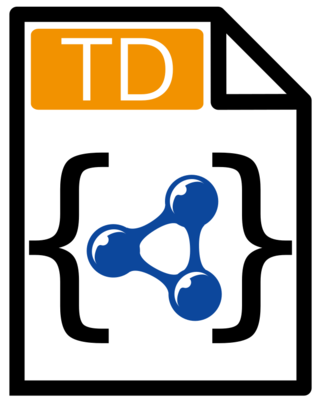A coverage is the digital representation of some spatio-temporal phenomenon. ISO 19123 provides the definition:
ISO 20022 is an ISO standard for electronic data interchange between financial institutions. It describes a metadata repository containing descriptions of messages and business processes, and a maintenance process for the repository content. The standard covers financial information transferred between financial institutions that includes payment transactions, securities trading and settlement information, credit and debit card transactions and other financial information.
In computing and data management, data mapping is the process of creating data element mappings between two distinct data models. Data mapping is used as a first step for a wide variety of data integration tasks, including:

Learning Object Metadata is a data model, usually encoded in XML, used to describe a learning object and similar digital resources used to support learning. The purpose of learning object metadata is to support the reusability of learning objects, to aid discoverability, and to facilitate their interoperability, usually in the context of online learning management systems (LMS).
The Extensible Metadata Platform (XMP) is an ISO standard, originally created by Adobe Systems Inc., for the creation, processing and interchange of standardized and custom metadata for digital documents and data sets.
NIEMOpen, frequently referred to as NIEM, originated as an XML-based information exchange framework from the United States, but has transitioned to an OASISOpen Project. This initiative formalizes NIEM's designation as an official standard in national and international policy and procurement. NIEMOpen's Project Governing Board recently approved the first standard under this new project; the Conformance Targets Attribute Specification (CTAS) Version 3.0. A full collection of NIEMOpen standards are anticipated by end of year 2024.
Geospatial metadata is a type of metadata applicable to geographic data and information. Such objects may be stored in a geographic information system (GIS) or may simply be documents, data-sets, images or other objects, services, or related items that exist in some other native environment but whose features may be appropriate to describe in a (geographic) metadata catalog.
Statistical Data and Metadata eXchange (SDMX) is a set of technical standards designed to describe statistical data and metadata, normalise their exchange, and improve their efficient sharing across statistical and similar organisations. It is published as ISO 17369.

Metadata is "data that provides information about other data", but not the content of the data itself, such as the text of a message or the image itself. There are many distinct types of metadata, including:
Electronic Business using eXtensible Markup Language, commonly known as e-business XML, or ebXML as it is typically referred to, is a family of XML based standards sponsored by OASIS and UN/CEFACT whose mission is to provide an open, XML-based infrastructure that enables the global use of electronic business information in an interoperable, secure, and consistent manner by all trading partners.

The Asset Description Metadata Schema (ADMS) is a common metadata vocabulary to describe standards, so-called interoperability assets, on the Web.
The following is provided as an overview of and topical guide to databases:
Data dissemination is the distribution or transmitting of statistical, or other, data to end users. There are many ways organizations can release data to the public, i.e. electronic format, CD-ROM and paper publications such as PDF files based on aggregated data. The most popular dissemination method today is the ‘non-proprietary’ open systems using internet protocols. Data is made available in common open formats.
NeTEx is the CEN Technical standard for exchanging Public Transport Information as XML documents. It provides a W3C XML schema based on the Transmodel abstract model of common public transport concepts and data structures and can be used to exchange many different kinds of data between passenger information systems, including data describing for stops, facilities, timetabling and fares. Such data can be used by both operational management systems and customer facing systems for journey planning etc.
UNIDOC is an XML-based standard to support electronic data interchange (EDI) in business transactions between trading companies. Unlike other XML-based EDI formats, such as UBL, ebXML, RosettaNet or openTRANS, UNIDOC relies one a single structure. The first idea of such a universal format was published in 2014, its first specification in 2016 in the journal of the Chamber of Commerce and Industry Swabia . The current specification can be found in the UNIDOC XML Schema Definition.

The Thing Description (TD) (or W3C WoT Thing Description (TD)) is a royalty-free, open information model with a JSON based representation format for the Internet of Things (IoT). A TD provides a unified way to describe the capabilities of an IoT device or service with its offered data model and functions, protocol usage, and further metadata. Using Thing Descriptions help reduce the complexity of integrating IoT devices and their capabilities into IoT applications.
A common data model (CDM) can refer to any standardised data model which allows for data and information exchange between different applications and data sources. Common data models aim to standardise logical infrastructure so that related applications can "operate on and share the same data", and can be seen as a way to "organize data from many sources that are in different formats into a standard structure".



